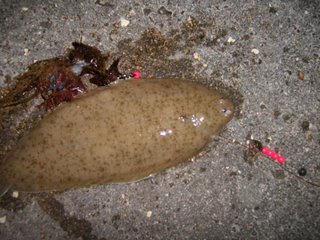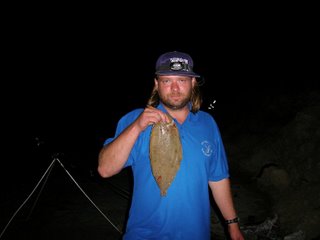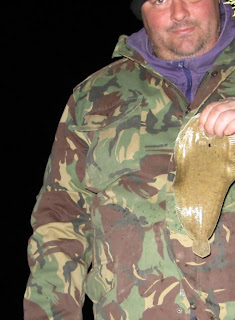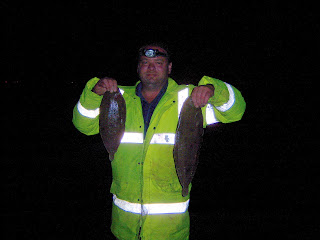Welcome to Dave`s sole fishing page!!
Earlier year posts can be viewed with the tabs to the right >>>
Earlier year posts can be viewed with the tabs to the right >>>
This is a page I`m dedicating to sole fishing. I have been targeting sole from the beach for around 14 years and find it a fun and relaxing type of fishing....and you really NEVER know what you are going to catch!
Sole fishing techniques/methods
VENUE, Find a sandy/muddy venue that has plenty of lug worm casts, or is known to hold ragworm.The best thing to do is look at low water or ask a local.A place where people dig bait is a sure bet!
RODS/REELS, Does not really matter what reel you use if you ask me,(i use fixed spools) though a rod whith a reasonably whippy tip should be used.
TACKLE, Use size 4 or 6 hooks on a 3 hook patternoster or a two hook one up one down rig. A wishbone or running leadger rig is ok but in all cases, keep snoods short, no longer than 12 inches. I always use grip leads as sole dont like bait movement, so nail the bait to the bottom and let the sole come to you. Another good trick is to put a 4 to 5mm lead shot just above the hook to really NAIL it down! If you want to use beads use red!
BAIT, Any type of lug has to be first choice, black lug/ blow lug/ yellow tails ect, though rag is often as good. Try lug and rag cocktails, this can be awsome and have had my biggest sole this way! Alot of people say use small baits, i dont! Use large baits for sole, whole worms or sometimes 2. Trust me it WORKS alot better! Also tipping worm baits with squid can do the job or tipping with winkles is a new trick of mine and it works well (also have had a few plaice this way while soleing)
TIDE, fish 2 hours each side of a high water thats bettween midnight and two in the morning. Try earlyer when nights get longer, but it normally has to be dark and late! Low waters are somtimes better in some spots so try both. Sole are often feeding in VERY close, so dont cast beyond 30 to 40 yards. Some venues, try closer!
WEATHER/MONTHS, Sole seem to like calm or slightly choppy conditions. They should start to come to the southern shores around the start of may, right through to the end of the year getting fatter as they go!!!
TACTICS, Keeping nice and quiet is a must as they are finiky feeders. Dont use a tilley and dont shine headlamps on the water, pretend you are not there and use stealth! Keep a small amount of slack line after you cast a tension may put them off! The most important rule is when you get a bite ....LEAVE IT dont strike as its probably just sucking on the bait. When its on you will know as it will normally go bezzerk and try to run, this is the time to reel in! Good luck!...........THIS IS MY PERSONAL CHOICE RIG THAT HAS NEVER LET ME DOWN
 But more recently i have been using the below rig for more deeper / closer casting marks, its very similar to the wishbone but does not tangle as much. Both hooks are on the bottom so you never risk having any hooks that are above the weight off the bottom. Its a good rig for marks where you may want your rod tips higher than normal (ie, due to strong tides / strong wind / weed on the waterline)
But more recently i have been using the below rig for more deeper / closer casting marks, its very similar to the wishbone but does not tangle as much. Both hooks are on the bottom so you never risk having any hooks that are above the weight off the bottom. Its a good rig for marks where you may want your rod tips higher than normal (ie, due to strong tides / strong wind / weed on the waterline)

RODS/REELS, Does not really matter what reel you use if you ask me,(i use fixed spools) though a rod whith a reasonably whippy tip should be used.
TACKLE, Use size 4 or 6 hooks on a 3 hook patternoster or a two hook one up one down rig. A wishbone or running leadger rig is ok but in all cases, keep snoods short, no longer than 12 inches. I always use grip leads as sole dont like bait movement, so nail the bait to the bottom and let the sole come to you. Another good trick is to put a 4 to 5mm lead shot just above the hook to really NAIL it down! If you want to use beads use red!
BAIT, Any type of lug has to be first choice, black lug/ blow lug/ yellow tails ect, though rag is often as good. Try lug and rag cocktails, this can be awsome and have had my biggest sole this way! Alot of people say use small baits, i dont! Use large baits for sole, whole worms or sometimes 2. Trust me it WORKS alot better! Also tipping worm baits with squid can do the job or tipping with winkles is a new trick of mine and it works well (also have had a few plaice this way while soleing)
TIDE, fish 2 hours each side of a high water thats bettween midnight and two in the morning. Try earlyer when nights get longer, but it normally has to be dark and late! Low waters are somtimes better in some spots so try both. Sole are often feeding in VERY close, so dont cast beyond 30 to 40 yards. Some venues, try closer!
WEATHER/MONTHS, Sole seem to like calm or slightly choppy conditions. They should start to come to the southern shores around the start of may, right through to the end of the year getting fatter as they go!!!
TACTICS, Keeping nice and quiet is a must as they are finiky feeders. Dont use a tilley and dont shine headlamps on the water, pretend you are not there and use stealth! Keep a small amount of slack line after you cast a tension may put them off! The most important rule is when you get a bite ....LEAVE IT dont strike as its probably just sucking on the bait. When its on you will know as it will normally go bezzerk and try to run, this is the time to reel in! Good luck!...........THIS IS MY PERSONAL CHOICE RIG THAT HAS NEVER LET ME DOWN
 But more recently i have been using the below rig for more deeper / closer casting marks, its very similar to the wishbone but does not tangle as much. Both hooks are on the bottom so you never risk having any hooks that are above the weight off the bottom. Its a good rig for marks where you may want your rod tips higher than normal (ie, due to strong tides / strong wind / weed on the waterline)
But more recently i have been using the below rig for more deeper / closer casting marks, its very similar to the wishbone but does not tangle as much. Both hooks are on the bottom so you never risk having any hooks that are above the weight off the bottom. Its a good rig for marks where you may want your rod tips higher than normal (ie, due to strong tides / strong wind / weed on the waterline)
The following is a great piece of info by mike ladle!

The senses of feeling, taste, smell and sight are those which feature most strongly in the flatty armoury. All flatfish have two eyes on the upper surface and two “noses”, a small one on the blind side and a bigger one on top. Consider a couple of examples. The Dover sole is a master of nocturnal hunting. Creeping about the seabed in the hours of darkness or when storms have turned the water the colour of oxtail soup these bloodhounds of the undersea world have no trouble finding the tiniest morsel of worm on the blackest night. How do they do that? Experiments in Holland have shown that the sole sniffs out prey which is lying quite still on the seabed by using the nostrils on its eyed side. If these are plugged to prevent the flow of water to the “nose” the fish have great difficulty locating prey. However, the sole has another trick up its sleeve. The furry touch sensors on the blind side of the head allow the fish to feel for its prey on the seabed. Recent studies have shown that the nocturnal sole has ten times as many “smell sensors” in its nose as the day time feeding plaice and three times the area of “smelling” tissue. No wonder sole will ignore food dangling above their heads as they search the surface of the sand for shrimps. Both plaice and sole feed on worms, shrimps and small clams but the plaice depends much more on its eyes to locate the prey. Smelling and tasting food is a great deal less important to the plaice than the sole. In fact the section of the brain used for smelling food is much smaller in the plaice than in the sole and the reverse is true of the section concerned with vision – hence the benefit of beads and spoons as attractors for plaice, flounder and similar species. Scientists have used special chemicals which temporarily knock out particular senses to find out exactly how flatfish locate their food in daylight and in darkness. Video cameras allowed the behaviour of the drugged fish to be watched. Both plaice and sole were able to feed – day and night. However, when the sense of touch had been numbed sole had difficulty catching live prey but were still able to find dead food. Knocking out its touch sensors made no difference to the hunting ability of plaice but the old spotties were not very good at feeding in the dark anyway and they would often mouth food items before spitting them out. On a slightly different tack, most anglers are aware that flatfish come in right-eyed (like the sole and plaice) and left-eyed (like the turbot and brill) varieties. The side which has the eyes develops camouflage colours allowing the fish to hide on the sea bed while they are hunting. In the past it has been suggested that the fish were able to improve their camouflage by imitating the background pattern. For example, some experiments in 1911 seemed to show that a flatfish could change colour, over a period of days, to imitate a chess board pattern. More recent studies have suggested that this work was wrong and that the results were due partly to photographic problems. Recently scientists in California set out to answer the question once and for all. The showed that not only could flatties blend into the background with ease but they could mimic checker-board patterns in a flash (2-8 seconds), a speed which would put the famed chameleon to shame. Tropical flatfish were much better at this colour change than our own cold water species. They were even able to “copy” big polka dot patterns by producing two large dark spots on the skin. The precision and fantastic speed of these changes suggests that the fish sees the pattern and its brain instantly signals the message to the pigment cells in the skin – a trick which, as far as we know, no other animal (except possibly some squid) is able to do. Anyway, next time you are down at the coast and your mate reels in a flounder, dab or plaice don’t say “it’s only another small flatty!" and rip it off the hook. Handle it carefully, like the marvel that it is, and return it to the sea to grow bigger and fight another day
Bless My Sole....Article by M Davies
My favorite fish to target is the Dover Sole and over the past 10 years I have enjoyed a certain amount of success around the Kent Coast even winning the 1999 Sole Open match at Dungeness. I much prefer to fish for the Sole on purely pleasure sessions when I am able to experiment and also when I am alone, as this species requires both still and quiet conditions. Several scores of 6oz leads crashing into the sea do not help at all when targeting this species. So very often, competitions fished over venues noted for large numbers of sole do not produce and I believe therefore that noise is obviously a factor.I find that still balmy nights or early morning sessions between July and October seem to produce best results but best of all are those times and tides that coincide with the still before a thunderstorm. The high pressure is perhaps a factor. However if you stay and fish through the storm is very careful as carbon-based fishing rods and lightning don't mix. I saw on man get struck twice in the same night on Deal Pier so the saying ' Lightning never strikes in the same place twice' is definitely wrong.Lets look at where to fish for this now quite common species.Living at Deal and within walking distance from the Pier makes a session easy and as long as I have bait I am able to pick a time and tide to suit at a moments notice. Deal Pier was opened in 1953 and is the only pier that I know that was built with the angler in mind. It has a long 'stem' from which angling is allowed on both sides and a Lower deck at the far end from which anglers can cast out into deeper water, but one of the best marks on the pier does not need a long walk. The stem has a section where the railings are painted yellow this denotes the area where boats are allowed to pass under the pier, and it is at the end of the yellow rails that you should set out to fish. The seats here are numbered and numbers 80 to 90 can produce good results.Fish 2 hours either side of the high tide on the south side of the pier (facing Kingsdown.) You do not need to cast far, in fact dropping under the pier can often be the place to be but I have found that you may need to try to find the sole as I believe the sand banks around here move and the fish move with them. Swing your tackle into the water or drop it and try not to make too big a splash let the tackle drop to the bottom and let out some slack line. Fishing into the tide allows the flow to push the tackle down so that all the hooks are on the bottom to get best results.The tackle I use here very often gets laughed at and seems to be 'old fashioned' but it gets results. I use very light rods usually a pair of Daiwa Bass rods but I have recently been trying Conoflex's Reflexor that was made for my daughter Emma for the World Championships last year in Portugal. It is ideal for fishing light for this species. I use a 3 or 4 oz breakaway lead and three metal French booms set about 1 foot apart. My hook length is made from 15lb Tritanium line to a size 6 kamasan B940 hook and is usually only 6 inches long. This set up looks strange but I can assure you, it gets results from the pier. As the tide eases I sometimes connect a small round lead between 1 and 3 oz. at the top of the trace. This helps to keep all three hooks in contact with the seabed. My bait here will vary and like the sand banks you may need to experiment to see what the fish are feeding on. I would always take ragworm but blow lug and wrapped yellow tails or combinations also work well. Keep the bait small and neat, half a worm will be enough to take fish up to 2lbs here.The other noted place on Deal pier is the far front left or north corner facing Ramsgate. There is a sand bank 30 to 40 yards out and in line with Ramsgate Harbour. Similar tackle or a standard 3 hook flowing trace, again with light hook lengths and size 6 hooks cast out here can produce results best tide is often over the Low water This mark will also produce large numbers of Dabs in the spring.My other favorite venues for sole are at Hythe behind the swimming pool and at Dungeness.At Hythe the low tide is often best and darkness will always be the best time. Fish very light again and don't be frightened to cast your tackle into the water at just a rode length out. Again try to be quiet don't make too big a splash. I recently fished a species competition here and caught six sole. I was using the Conoflex Reflexor and I went down to size 10 hooks with small pieces of ragworm and bunches of maddies (Harbour rag) the fish were taken at about 15 feet in on a very calm night. I found here that if I cast further out I found rough ground for about 20 to 30 yards on the low tide but I did catch fish when I found the softer ground. On the High tide you therefore need to cast either in front of this rough ground or over it.At Dungeness park your car near the gate to the road that goes around the back of the power station but be careful not to leave valuables in the car as there has been trouble with thieves. Walk to the end of the fence and turn around the back of the power station about 50 yards.Here there is a hut on the beach. (I think bird watchers use it.) Fish anywhere here for excellent results. Use a 3-hook trace with one of the hooks dropping below the weight. The hook length again I prefer to be light and clear and about 21" long. I use a size 6 or 4 Kamasan B940, The size 4 hook is probably needed as here the fish can be up to 3lb and when they coil their body into the tide like a sail they can easily pull themselves off the hook. Here I have had best results with black lug and lug tipped with ragworm. Don't be afraid to fish close in here but be prepared to experiment and try again to find the distance at which the fish are feeding normally a cast of 40 to 50 yards will be sufficient but if you are fishing with two rods vary the distances. Best times to fish here is over the low tide up and nighttime and early mornings can produce large numbers of good fish.The sole when feeding tends to settle over the bait and suck it into their very small mouth. Your rod tip may quiver and twitch but be patient as the fish needs time to get the bait into the mouth. When the bait is taken and the fish moves the rod tip may lurch forward as if taken by a cod and may drop back slack. You can reel in now and may be rewarded with two or three fish for your patience.Don't forget be quiet. Cast your tackle into the sea with care. Don't make too much splash when casting your weight into the sea and be patient when you see the rod tip rattles.I hope these tips will help you when it comes to catching sole. They are now common around the English coast and with a little thought can be easily caught. Use small hooks; light tackle and small ragworm or lug baits and your results should improve.
Labels: Isle of wight sole fishing bait hooks digging weather weights line





































































